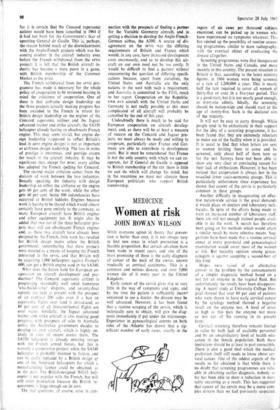After the AFVG
AVIATION DAVID W. WRAGG
Although the French withdrawal from the Anglo-French Variable Geometry (swing wing) aircraft project was not unexpected, it shat- tered the illusion of those who looked upon the series of aircraft projects for joint develop- ment by the British and French aircraft industries as the ideal solution to the problems associated with the continued existence of a first-class aircraft industry, spreading develop- ment costs over a, theoretically, doubled market.
It would be wrong to deny that there are many advantages in cooperation, one of which still must be the reduced risk of cancellation:-
for it is certain that the Concord supersonic airliner would have been cancelled in 1964 if it- had not been for the Government's fear of upsetting General de Gaulle. This is, perhaps, the reason behind much of the disenchantment with the Anglo-French projects which was be- coming evident in the aircraft industry even before the French withdrawal from the AFVG project; it is felt that the British aircraft in- dustry has become a mere pawn in -a game, with British membership of the Common Market as the prize.
The French withdrawal from the AFVG pro- gramme has made it necessary for the whole policy of cooperation to be reviewed bearing in mind the criticisms of cooperation. One of these is that airframe design leadership on the three projects actually making progress has been awarded to the French in return for British design leadership on the engines of the Concord supersonic airliner and the Jaguar advanced trainer and strike aircraft; the SA330 helicopter already having an obsolescent French engine. This may seem trivial, but engine de- sign leadership (supposed to reflect Britain's lead in aero engine design) is not as important as airframe design leadership. The loss in terms of prestige is enormous, and prestige counts for much in the aircraft industry. It may be significant. that, except for BOAC, every airline has adopted the French spelling for Concord.
The second major criticism comes from the division of work between the two industries. Broadly speaking, the industry with design leadership on either the airframe or the engine gets 60 per cent of the work, while the other gets 40 per cent. Some 500 redundancies have occurred at Bristol Siddeley Engines because work is having to be shared which would almost certainly have gone entirely to the company, as many European aircraft have British engines and other equipment too. It might also be added that two out of the three helicopter pro- jects may still use obsolescent French engines and, as these two aircraft have already been designed by the French, little work has resulted for British design teams unless the British government, remembering that these projects were mooted as a means of keeping the French interested in the AFVG, and that Britain will be acquiring 1,000 helicopters against France's 600, can get a British engine used in the SA340.
What does the future hold for European co- operation on aircraft development and pro- duction? The Concord supersonic airliner is progressing reasonably well amid numerous 'who-builds-vs hat' disputes, and seventy-four options are held at present with the prospect of an eventual 200 sales even if a ban on supersonic flights over land is introduced, as N per cent of all intercontinental flights are over water. Similarly, the Jaguar advanced trainer and strike aircraft is also making good progress, with prospects of sales to Australia unless the Australian government decides to develop its own aircraft, which is highly un- likely in view of recent events there. The SA330 helicop:er is already entering service with the French armed forces, but this is scarcely a cooperative project; while the SA340 helicopter is probably doomed to failure, and can be easily replaced by a British design qr one of the American helicopters for which a manufacturing licence could be obtained, as in the past. The British-designed WG13 heli- copter is not popular with the French, but will still enter production because the British re- quirement is large enough on its own.
The real questions, of course, arise in con- nection with the prospects of finding a partner for the Variable Geometry aircraft, and in getting a decision to develop the Anglo-French- German airbus, the A300. A source of dis- agreement on the AFVG was the differing requirements of Britain and France which would, in any case, have increased development costs enormously, and so to develop this air- craft on our own need not be too costly. It would be difficult to find a partner without encountering the question of differing specifi- cations because, apart from ourselves, the United States and Australia are the only nations in the west with such a requirement, and Australia is committed to the F111, much to her regret. Cooperation on the Republic- EWR AVS aircraft with the United States and Germany is not really possible as this most complicated of all aircraft will probably be cancelled by the end of this year.
Undoubtedly there is much to be said for European cooperation on aircraft develop- ment, and, as there will be at least a measure of success on the Concord and Jaguar pro- jects, we must always be ready and willing to cooperate, particularly once France and Ger- many are able to contribute to development costs. But it must be remembered that France is not the only country with which we can co- operate, for if Genetal de Gaulle is opposed to British membership of the EEC there is little we can do which will change his mind, but in the meantime we must not alienate those European politicians who support British membership.































 Previous page
Previous page